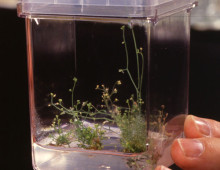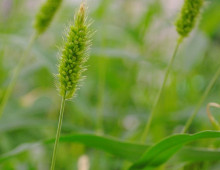Found worldwide, microbial mat communities are often the pioneering species in perturbed environments and can represent the only biota in extreme habitats. These associations are well-adapted to a range of harsh conditions that include extremes of temperature, salinity, high or low oxygen levels, and nutrient deprivation. In many cases, microbial mats are highly productive biochemical…
NutNet soil metagenomes
Terrestrial ecosystems worldwide are receiving elevated inputs of nitrogen and recent studies suggest that the additional nitrogen is impacting soil carbon sequestration rates. It has been speculated that nitrogen additions alter the microbial processing of organic carbon pools, inhibiting decomposition of certain pools and accelerating soil carbon sequestration. This project focuses on shotgun metagenomic sequencing…
Single-cell sequencing of iron-oxidizing bacteria
Iron is the fourth most abundant element in the Earth’s crust and is potentially one of the most abundant energy sources on Earth. Deep sea hydrothermal vents deposit iron oxides into the oceans annually. Several decades ago, the first hints of unusual microbial communities associated with iron oxides at seamounts came from samples collected by…
Bacterial symbionts of gutless marine worms
More than 100 species of gutless worms have been found in marine sediments around the world, and they have formed symbiotic relationships with bacteria that provide them with nutrition and have enabled them to colonize nutrient-poor environments. The symbionts are so efficient at feeding their hosts and recycling their waste compounds that the worms have…
Carbon-storing bacteria in rhizosphere soils
Microbes are able to store carbon under suboptimal growth conditions in culture, but the extent to which they store carbon in bulk or rhizosphere soil are not well understood. One stress response observed in microbes is the production of carbon storage granules as a means of trapping the needed carbon in the soil. Understanding the…
Assembling plant microbiomes
The relationships between plants and the microbes in the surrounding soil influences nutrient uptake, disease resistance and stress tolerance. Essentially all land plants grow in intimate association with complex microbial communities both above the ground (phyllosphere) and below the ground on roots and the immediately surrounding area (rhizosphere) and deep inside root intercellular spaces (endophytes)….
Fungal plant pathogens and energy feedstocks
The fungal genus Colletotrichum is one of the most common and destructive groups of plant pathogenic fungi, causing disease on plants from nearly every crop and natural ecosystem worldwide. Fourteen species are known pathogens of grasses and cereals, including several candidate bioenergy feedstocks. The impact of Colletotrichum on next-generation bioenergy feedstock production and yield could…
Microbes in Antarctica’s Dry Valley
The Antarctic Dry Valley system represents one of the harshest and most extreme environments inhabited by microorganisms on Earth. The soils of these valleys contain microbes that must cope with cold temperatures, poor water and nutrient availability, high salinities, exposure to high doses of ultraviolet radiation, and lack of sunlight during polar winters. Such an…
Boosting biomass of perennial grasses
Switchgrass and prairie cordgrass are candidate bioenergy feedstocks while Brachypodium distachyon is a model grass being used to study related candidate bioenergy feedstocks that was sequenced at the DOE JGI. All three plants have relationships with fungi that lead to benefits such as increased biomass and stress resistance. By studying the transcriptome –the tiny fraction…
Green foxtail as a model C4 grass
Setaria viridis is the wild progenitor of S. italica, more commonly known as foxtail millet. Green foxtail is related to other grasses that have been considered candidate bioenergy feedstocks such switchgrass, Miscanthus and sorghum. Both green foxtail and foxtail millet have been sequenced by the DOE JGI, and this project focuses on understanding and promoting…


